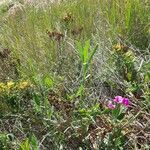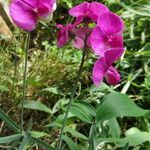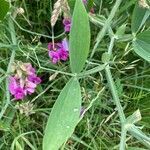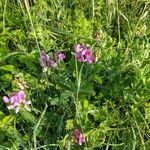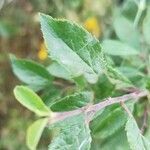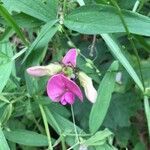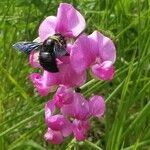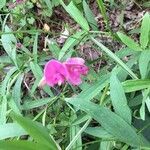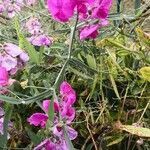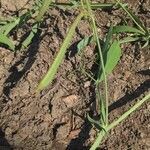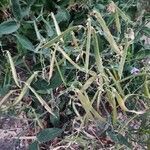A climber which grows 1.5-3 m high. It keeps growing from year to year. It has a deep tough root system. The stems are winged. The leaves are blue-green. There are 2 leaflets. They are opposite and sword shaped. They are 3-10 cm long by 1-4 cm wide. They have a small sharp tip at the end. The leaf stalk has wings. There is a tendril at the end of the leaf stalk. It is usually branched. The flowers are pink and in clusters. There are 3-14 flowers in a group. The stalk is 3-15 cm long. The petals are magenta colour. The pods are narrowly oblong. They are 5-10 cm long and 0.6-1 cm wide. There are 10-15 seeds. The pods are smooth and light brown. The seeds are rough and with a net like pattern. They are 6 mm long.
Herbs perennial, to 3 m tall. Stem erect, quadrangular, pubescent or glabrous, winged. Leaves with branched tendril at apex; stipules semisagittate, lanceolate to ovate; leaflets 1-paired, elliptic to elliptic-orbicular, or ovate to linear, (30-)40-150 × 3-50 mm, with parallel veins. Raceme 5-15-flowered. Calyx campanulate, ca. 6 mm, equally 5-toothed. Corolla purple to pink, (15-)20-30 mm. Style twisted. Legume brown, 5-11 cm, glabrous. Seeds 10-15.
Rhizomatous perennial; stems trailing or climbing to 2 m, broadly winged, 5–10 mm wide; stipules ovate or lanceolate, with a basal lobe, 2.5–4 cm; petiole broadly winged; lfls 2, lanceolate to elliptic, 4–8 × 1–3 cm; peduncles 10–20 cm, with a raceme of 4–10 anthocyanic or white fls 1.5–3 cm; cal-lobes very unequal; fr 6–10 cm, 10–15-seeded; 2n=14. Native of s. Europe, tending to escape from cult. esp. toward the s. part of our range. June–Aug.
